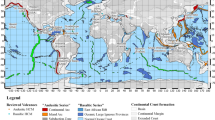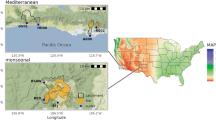Abstract
Counter to intuition, small-scale measurements of hydraulic conductivity do not average to regional values. Instead, mean hydraulic conductivity increases with measurement scale up to a critical distance termed the range, beyond which a constant regional value prevails. Likewise, variance in log hydraulic conductivity increases with separation distance between measurement points as the spatial correlation decreases. As dissolution proceeds in carbonate aquifers, heterogeneity and the volume necessary for an equivalent homogeneous medium (EHM) both increase. As these variables increase, the range of scale increase in both mean hydraulic conductivity and variance increases proportionately. Consequently, the range in scale effects is a reliable measure of the degree of secondary dissolution. By correlating the numeric value of range with independently measured hydraulic properties, the prevalent type of flow system, diffuse, mixed or conduit can be determined.
Similar content being viewed by others
References
Bradbury KR and Muldoon MA (1990) Hydraulic conductivity determinations in unlithified glacial and fluvial materials. In: Nielson DM and Johnson AI (Eds), Hydraulic conductivity and waste contaminant transport in soils. Philadelphia: American Society for Testing and Materials, ASTM STP 1142:138–151
Carman J (1991) Aquifer characteristics of the shallow Burlington-Keokuk Limestone at the Weldon Spring Site. Proceedings of the Geosciences Workshop, O'Fallon, Missouri. DOE Contract DE-AC05-86OR21548:155-201
Cherkauer DS and Mikulic DG (1992) Development of hydrostratigraphic model for the interaction of ground water with Lake Michigan in southeastern Wisconsin. Final report to University of Wisconsin Sea Grant Institute, Madison, Wisconsin, Project R/NI-14, 84 pp
Cherkauer DS and Nader DC (1989) Distribution of groundwater seepage to large surface-water bodies: The effect of hydraulic heterogeneities. Journal of Hydrology 109:151–165
Degirmenci M (1993) Karstification at Beskonak dam site and reservoir area, southern Turkey. Environ Geol 22:111–120
Durham L (1991) Groundwater modeling at the Weldon Spring chemical plant/raffinate pits and vicinity properties. Proceedings of the Geosciences Workshop, O'Fallon. Missouri. DOE Contract DE-AC05-86OR21548:203–228
Ford DC and Williams PW (1989) Karst geomorphology and hydrology. London: Unwin Hyman 320 pp
Garstang M (1991) Collapse potential evaluation of the defined study area at the Weldon Spring chemical plant site, Weldon Spring, Missouri. Proceedings of the Geosciences Workshop, O'Fallon, Missouri. DOE contract DE-AC05-86OR 21548:277–295
Guyonnet D, Mishra S, and McCord J (1993) Evaluating the volume of porous medium investigated during slug tests. Ground Water 31(4):627–633
Hess KM, Wolf SH, and Celia MA (1992) Large-scale natural gradient test in sand and gravel, Cape Cod, Massachusetts 3. Hydraulic conductivity variability and calculated macrodispersivities. Water Resour Res 28(8):2011–2027
Isaaks EH and Srivastava RM (1989) An introduction to applied geostatistics. New York: Oxford University Press 561 pp
Kleeschulte MJ and Emmett LF (1987) Hydrology and water-quality at the Weldon Spring radioactive waste-disposal sites, St. Charles County, Missouri. US Geological Survey Water Resources Investigations Report 87-4169, 65 pp
McBride MS and Pfannkuch HO (1975) The distribution of seepage within lakebeds. J Res US Geol Surv 3(5) 505–512
MMSD (Milwaukee Metropolitan Sewerage District) (1981) Inline storage facilities plan 4: Borehole logs, unnumbered.
MMSD (Milwaukee Metropolitan Sewerage District) (1984) North Shore interceptor geotechnical report 3: Contract documents, unnumbered.
MK-Ferguson Company and Jacobs Engineering Group (1990) Aquifer characteristics data report for the Weldon Spring site chemical plant/raffinate pits and vicinity properties. St. Charles, Missouri, DOE Contract No, DE-AC05-86OR21548, 111 pp
Price P (1991) Shallow groundwater investigations at Weldon Spring, Missouri. Proceedings of the Geosciences Workshop, O'Fallon, Missouri, DOE Contract DE-AC05-86OR21548:141–153
Quinlan JF and Ewers RO (1985) Ground water flow in limestone terranes: Strategy rationale and procedure for reliable, efficient monitoring of ground water quality in karst areas. In: Proceedings, Fifth national symposium and exposition on aquifer restoration and ground water monitoring. Worthington, Ohio: National Water Well Association pp 197–234
Quinlan JF, Smart PL, Schindel GM, Alexander EC, Edwards AJ and Smith AR (1991) Recommended administrative/regulatory definition of karst aquifer, principles for classification of carbonate aquifers, practical evaluation of vulnerability of karst aquifers, and determination of optimum sampling frequency at springs. In: Proceedings of the third conference on hydrogeology, ecology, monitoring, and management of ground water in karst terranes. Dublin, Ohio: National Ground Water Association pp 573–635
Rovey CW and Cherkauer DS (1994a) Relation between hydraulic conductivity and texture in a carbonate aquifer: Observations. Ground Water 32(1):53–62
Rovey CW and Cherkauer DS (1994b) Relation between hydraulic conductivity and texture in a carbonate aquifer: Regional continuity. Ground Water 32(2):227–238
Rovey CW and Cherkauer DS (1994c) Scale dependency of hydraulic conductivity measurements. Ground Water (in press)
Sauter M (1991) Assessment of hydraulic conductivity in a karst aquifer at local and regional scale. In: Proceedings of the third conference on hydrogeology, ecology, monitoring, and management of ground water in karst terranes. Dublin, Ohio: National Ground Water Association pp 39–56
Shuster ET and White WB (1971) Seasonal fluctuations in the chemistry of limestone springs: A possible means for characterizing carbonate aquifers. J Hydrol 14:93–128
Smart PL, Edwards AJ, and Hobbs SL (1991) Heterogeneity in carbonate aquifers; effects of scale, fissuration, lithology and karstification. In: Proceedings of the third conference on hydrogeology, ecology, monitoring, and management of ground water in karst terranes. Dublin, Ohio: National Ground Water Association pp 373–387
Teutsch G and Sauter M (1991) Groundwater modeling in karst terranes: Scale effects, data acquisition and field validation. In: Proceedings of the third conference on hydrogeology, ecology, monitoring, and management of ground water in karst terranes. Dublin, Ohio: National Ground Water Association pp 17–34
White WB (1969) Conceptual models for carbonate aquifers. Ground Water 7(3):15–21
White WB (1988) Geomorphology and hydrology of karst terranes. New York: Oxford University Press 464 pp
Author information
Authors and Affiliations
Rights and permissions
About this article
Cite this article
Rovey, C.W. Assessing flow systems in carbonate aquifers using scale effects in hydraulic conductivity. Geo 24, 244–253 (1994). https://doi.org/10.1007/BF00767085
Received:
Accepted:
Issue Date:
DOI: https://doi.org/10.1007/BF00767085




